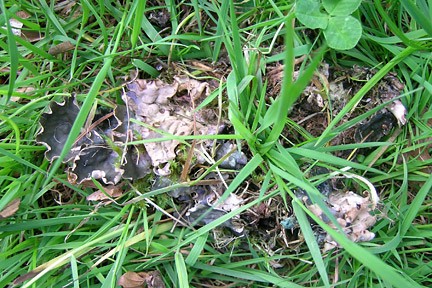Turf & Lawn Blog
Lawn problems | Part 1 : Moss, lichens & algae
Why do problems occur in lawns, and what can you do about it? In this series of articles, we plan to provide information about common problems, what causes them, and what you can do to prevent or cure them. The first in the series is about moss, lichens and algae.
Lichens, algae and liverworts can appear in lawns in shady patches, especially if the drainage is poor, as they like the cool, damp conditions. Compacted soil seems to be especially prone to growth, so the drip line of trees can be a problem area.
What can you do about it? Well, there aren’t many chemical controls specific to algae or lichen, but fortunately, lawn mosskillers containing ferrous sulphate will also kill off algae and lichen. But actually, if you sort out your drainage problems, you should see your algae disappear as well.

If it is the top layer of the lawn turf that seems to be poorly drained, then spike it with a garden fork or aerator every 10-15 cm. If the compaction or waterlogging is only in patches, aerate the patches during wet weather every four to five weeks. On heavy clay soils, a hollow-tine aerator will be more effective than a garden fork. If your lawn remains waterlogged, you might have to consider installing an artificial drainage system.
After aerating, top dress with sharp sand, which you can buy from garden centres. This will improve the drainage. Try to avoid walking on the lawn when it is wet, as this will increase compaction. At the very least, take different routes across it! And finally, but most importantly, make sure that you carry out your routine maintenance, especially in the autumn, to keep your lawn turf healthy.
Moss tends to grow when the grass isn’t growing. So conditions that stress the grass tend to favour moss. Oddly enough, that includes both drought and waterlogging, but can also include wear and tear such as along paths, or shade. You can treat the moss, but if you don’t sort out the conditions that caused the grass to stop growing, it will recur again.
To treat the moss, you can remove it by hand, using a spring-tine rake, in the autumn. This process is called scarifying, and if you have a large lawn, you can hire a mechanical scarifier to help. You can also treat it with moss killer, several of which are available to buy. It may also be helpful to use a fertiliser mixed with moss killer, to encourage the grass to grow back as well. The time to use a moss killer is spring, which fortuitously is also a good time to feed the lawn, or early autumn, when you need to use the moss killer alone to avoid encouraging too much growth before the winter frosts.
When you subscribe to the blog, we will send you an e-mail when there are new updates on the site so you wouldn't miss them.
